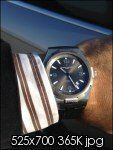As oxymoronic as the notion of a luxury sports watch may be linguistically- after all, isn’t inutility a necessary prerequisite for the rarefied quality of true luxury?- a really well done sports watch has an indisputable feel of integrity and refinement all its own. The Vacheron Constantin “Overseas” line of sports watches is especially interesting in this regard, as it represents an attempt to extend the qualities of a manufacturer whose name is synonymous with elegance- and with deliberate elegance, in contrast to the perhaps more conservative classicism of Patek or the deliberate (some might cynically say mannered) austerity of Lange- into the domain of sports watches. The House of Vacheron, which recently celebrated its 250th anniversary, has in the last few years extended its range of watches both in terms of styles and in terms of engineering achievements, fielding a new hand-wound movement in the cal. 1400, as well as the new automatic movement cal. 2475, and offering a variety of sports watches, dress, and complicated pieces, as well as lady’s watches and a separate line of jeweled watches.
Although the current design entered the market in 2004, the Overseas was first introduced in 1996 in a smaller, thinner version, employing VC cal. 1310 (based on an ebauche sourced from Girard Perregaux) and was both rather flatter and smaller in diameter than modern tastes demand (ref. 42042 was 37mm in diameter and ref. 42052 was slightly smaller at 35mm.) As representatives of the first generation of dress/sports watches the Overseas incarnated the same general aesthetic represented by the Patek Philippe Nautilus, the Audemars Piguet Royal Oak, and the Girard Perregaux Laureato, all of which offered the robustness of a stainless steel case and integral bracelet with the thinness and ease of wear of a dress watch.
#
The Case, Dial and Bracelet
In 2004, Vacheron fans were treated to a substantial makeover of the Overseas. A number of changes were made, some more immediately apparent than others. The most obvious change was an increase in both the size of the watch and the general elaborateness of its finish- the Overseas is now a 42mm watch, well in line with modern tastes for watches with a palpable presence on the wrist and to the eye. With the increase in size comes a greater scope for demonstration of the restrained elegance and even opulence that sets Vacheron Constantin apart. The bracelet now is made of sculptured links which are fashioned in Vacheron’s distinctive Maltese cross motif, and the individual links are finished with beautifully executed tapering bevels which catch the light and give the bracelet a wonderful jewel like variation between alternating bands of light and dark.
The Maltese cross motif has been extended to the bezel as well, which in addition to reflecting the Maltese cross shape is also reminiscent of the profile of gears. Links from the bracelet, as well as the shroud of the crown guard, interlock with the concavities of the bezel, reinforcing the sense of the presence on the wrist of a luxurious machine. The case continues the subtle beveling found on the flanks of the bracelet links as well as the brushed finish on the upper surfaces, and the execution of the steelwork overall throughout the case and bracelet in terms of quality and attention to detail is no less than what would expect from Vacheron Constantin, which is to say, uniformly excellent.
In the example provided for review the dial is equally immaculately finished, with a subtle engraved pattern that offsets the large applied numerals at the quarters of the dial without distracting from them. The dial gives up nothing in refinement to achieve legibility- the sword hands and generously sized markers, all enhanced with ample luminous material, and the metal surrounds of the hour markers, all contribute to the at-a-glance readability of the dial, while the outer minute track adds just a touch of gravitas and pragmatic sense of purpose to remind the owner that elegance notwithstanding, the Overseas is more than capable of coping with the rigors of daily use- this is not a watch designed to oscillate in splendid isolation on a winder, but rather to be used and enjoyed on the wrist.
#
The Movement
Vacheron cal. 1310, used in the original Overseas, has now been replaced by a new caliber, designated VC cal. 1126/1, which is developed by Vacheron Constantin from the JLC cal. 889.
The movement is revealed by removing the caseback and antimagnetic inner case. The general impression of conservative solidity continues through examination of the caseback, which is held on with six screws and which bears a lovely engraving of a ship under full sail on a turbulent ocean- indeed, overall one has the feeling of watching a sister vessel through the porthole of another ship. We also note that the watch carries a 150 meter water resistance rating, falling shy of being an actual scuba diving suitable watch by 50 meters, but nonetheless more than capable of surviving an occasional immersion.
Removing the caseback exposes the antimagnetic inner case- the Overseas’ impression of robustness and resistance to the effects of a rough and tumble environment is clearly more than skin deep. Interestingly, there is a square of plastic material on the inner surface of the caseback, whose function is not immediately apparent- possibly it serves to stabilize the antimagnetic inner case in some way, although if in fact that’s its intended purpose its presence would seem more insurance than necessity as the inner case is held firmly in place with three retaining screws.
#
#
#
#
Removal of the antimagnetic inner case allows us to inspect VC cal. 1126/1.
In general, the first impression is of a classically finished automatic movement which has been thoroughly worked over to ensure its adherence to Vacheron’s high standard of both visual and chronometric refinement. The rotor is finished with irreproachably executed cotes de Geneve and has been upgraded with a solid and very massive 21 karat gold rim weight, ensuring efficiency in winding by placing a large mass at the furthest radius from the center of rotation. Offsetting the mechanical loads created by this considerable weight are ceramic rather than metal ball bearings, which are increasingly being adopted by many haute horlogerie manufactories as offering a solution to the problems of wear and lubrication created by ordinary steel bearings. The rotor is held in place with three blued screws and sunray brushing on the central bearing contrasts nicely with the screws and their countersinks. As the engraved rotor notes, the movement has been adjusted in five positions and for heat, cold and isochronism, and runs in a total of 36 jewels.
#
#
Removing the rotor and setting it aside, we can see a large semi-circular bridge covering approximately half the movement- here we can inspect the jewels holding the upper pivots of the barrel, great wheel, center seconds pinion, and the automatic winding train. Also exposed is the jeweled rocker which allows for winding in both directions of rotation of the winding rotor.
Removing the bridge we next come to the automatic winding train itself.
#
#
At the lower right are the barrel and ratchet wheel. The ratchet driving wheel has a three pronged, claw shaped spring which allows disengagement of the ratchet driving wheel during hand-winding. If the pinion of the driving wheel is driven counter clockwise by the ratchet wheel (during hand winding) the claws (which are connected to the driving wheel pinion) are lifted free of engagement with the holes in the ratchet driving wheel, disengaging the automatic winding train. This is a commonly used, well tried, and reliable design.
Essentially, the power flow from the rotor runs as follows: the rotor gears to a ceramic ball-bearing mounted intermediate wheel
#
(visible here to the left of the main rotor bearing, held in place with a single blued screw)
#
which engages the first rocker wheel. Depending on whether the rotor is rotating clockwise or counterclockwise either the first or second rocker wheel engages with the asymmetrically toothed click wheel. The click wheel, in addition to engaging with a small click, carries a pinion which gears to the intermediate winding wheel. The intermediate winding wheel engages the ratchet driving wheel, which then drives the ratchet wheel to wind the mainspring.
A couple of features of the automatic winding train bear noting; first, the small click that engages the asymmetrical teeth of the following wheel is the only click for the entire winding train; there is no conventional ratchet wheel click. A second interesting point is that the endshake of the barrel arbor and the ratchet wheel cannot be easily adjusted as the entire ratchet wheel is under the barrel bridge (which also holds the pivots for the click wheel, intermediate wheel, ratchet driving wheel, great wheel, and center seconds pinion, seen in the center of the picture.) To address this potential problem JLC makes a special movement holder with a spring-loaded device that puts pressure on the underside of the barrel arbor when the movement is assembled. This allows the watchmaker to apply pressure to the barrel arbor and check to see if the ratchet wheel is sufficiently free.
The gear train is well constructed, and well finished throughout, with concentric brushing, clean tooth profiles, and beveled spokes, carrying through the impression of solidly done decorative and functional finish.
#
## #
#
## #
click pictures for larger view
#
Moving further along the train, we come to the escape wheel, pallet fork, and balance assembly. Here we can view the upper and lower jewel settings for the escape wheel. These are both two jeweled settings, with a lower jewel and an upper cap jewel. The upper and lower cap jewels are fixed, which means that the jewel settings can’t be disassembled for cleaning. In order to facilitate servicing, there are actually three tiny vents in the escape jewel settings which allow fluid to penetrate the jewel settings when cleaning the movement ultrasonically. In this approximately one year old watch, for some unknown reason, the escape wheel pivots were dry, the oil having bled out of the jewels. The pallet fork is cleanly finished.
#
One interesting aspect to this particular movement is that adjustments have been made to the train, which appear to have been intended to reduce the amount of power reaching the escapement and balance wheel. The reason for doing so may be that the movement was showing excessive amplitude, possibly as a result of the sensitivity that this movement reputedly shows to variations in mainspring strength. The solution used in this case was to bend the tension spring which regulates the sweep seconds pinion’s motion, so as to put more drag on the pinion and subtract power from the train. As a result, some wear is visible on the sweep seconds pinion. Functionally this is not likely to cause significant wear to the pinion itself, at least not in the immediate future, although as far as the tension spring is concerned it is probable that it would need to be replaced due to wear in a much shorter time frame.
#
####
click pictures forlarger view
#
#
#
The Keyless Works
#
#
Somewhat unusually, the keyless works in VC cal. 1126/1 are located under the barrel bridge and not (as is usually the case) on the dial side of the movement. The keyless works, while not elaborately finished are nonetheless more than competently executed, and there is an interesting and very well done set lever, apparently made of beryllium bronze (though the detent screw that holds it in place was apparently slightly marred during assembly.) The rocking bar at the top is nicely straight grained and the yoke to the immediate left engages a rather clever combination stop lever/yoke spring; the stop lever is visible extending to the top of the photograph. The single blued screw visible is also the only one visible when the bridge is installed.
#
The Handwinding Train
#
#
The handwinding train has 3 wheels; on the far left is the crown wheel, the wheel with three slots in the middle is the intermediate hand winding wheel, and on the right is a sliding gear mounted on a yoke that pivots under the intermediate crown hand winding wheel so that when you wind the watch, the sliding gear engages with the ratchet wheel, but when automatic winding is engaged the gear disengages. In conjunction with the three-pronged spring on the ratchet driving wheel, this ensures that during handwinding the automatic train is disengaged and during automatic winding the handwinding train is disengaged, thus avoiding unnecessary wear to both; a nice touch calculated to increase the longevity of both sets of components.
The Calendar Works
#
#
#The calendar works for the instantaneous date switching mechanism are visible on the dial side, here shown with the calendar ring removed. To the right are two wheels; the lower, slightly larger wheel rotates once every 24 hours, counterclockwise, and has a lobe which engages the large, dog’s head shaped piece occupying the bottom third of the picture, which is technically known as a date wheel pawl. The date wheel pawl is pulled to the right as the lobe on the 24 hour wheel engages with it, and then, as the 24 hour wheel continues to rotate counterclockwise, the lobe on the wheel disengages from the date wheel pawl, which is snapped back to the left under the tension of the bronze colored spring visible on the left side of the picture; this advances the date wheel one increment. The smaller, lighter colored upper wheel on the right carries three fingers on its underside and rotates during date setting; a lever carried on a pin attached to the underside of the beryllium bronze set lever is visible to the far right and this moves a lever which carries an intermediate wheel which in turn gears to the date-setting wheel. The date wheel pawl essentially floats freely in its recess, and is held in place simply by the geometry of the recess and the tension of the two springs pressing against it . The cover plate for the lower of the two springs is visible to the right, and has a perplexingly unfinished surface, a slight disappointment though also the only such minor lapse in the entire movement.
The remainder of the components on the dial side, including the movement plate itself certainly do exhibit the level of finish found throughout the rest of the movement. One last feature of some interest on the dial side is the compound cannon pinion. It looks almost like two traditional cannon pinions one on top of the other and functions much like the two-piece cannon pinions found in modern ETA movements, with the upper piece friction coupled to the lower and acting as a slipping clutch during handsetting. Like a center wheel or minutes pinion in some movements, it is driven directly by the barrel. A minor disappointment is that the jumper for the date ring is riveted to the mainplate rather than held in place with a screw- though again, riveted components are to be found to some degree in many higher grade movements.
#
Conclusions
Although the current version of the Vacheron Constantin Overseas is in some respects an evolution of its previous incarnation, it is also in many interesting respects really a very different watch, with a considerably reworked and more elaborate, sophisticated case and bracelet design as well as a generally sportier feel. It also encloses a different movement which however is based on a tried and true caliber with a trustworthy history of employment in a wide variety of environments, and as implemented by Vacheron Constantin, the recipient of careful adjustment which in this example produced, for the current owner, excellent accuracy on the wrist. The watch overall gives a very masculine yet still refined impression- a sturdy, striking, yet unostentatious watch, which in its combination of versatility and elegance can be worn anywhere the owner cares to take it.
When it was first introduced, there were certainly those who expressed some sense of loss over the end of production of the thinner, smaller versions. While the earlier references were also wonderful watches in their own right, the new Overseas stands very much on its own merits as an expression of the values and quality we have come to expect from the house of Vacheron Constantin.
Jack Forster
#
Watch disassembly, photography, and all technical notes thanks to ThePuristS.com technical advisor. Any and all errors are the responsiblity of the credited author alone.
#












 )
) :
: